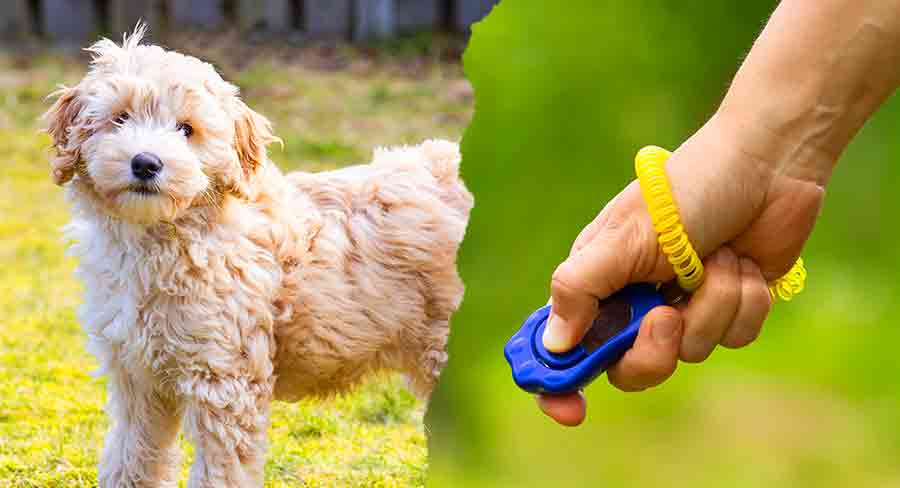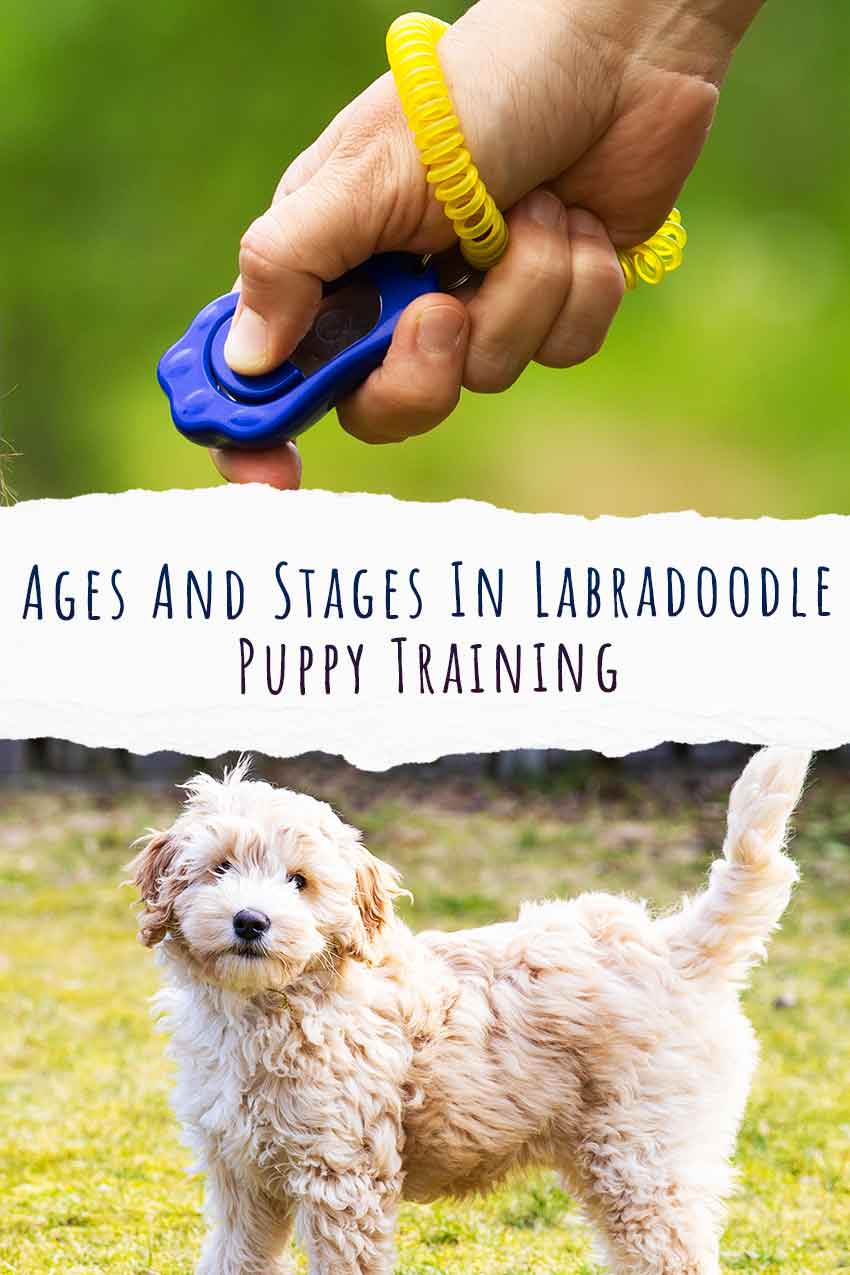Training your puppy is so much easier when you know what you are aiming for. In this article we’ll look at what you can expect from your Labradoodle puppy at each stage of their development, and give you tips and tricks for helping them to stay on the right track.
Ages and Stages in Labradoodle Puppy Training
I have broken down my general pattern of training into sections, to help guide you in your puppy training journey. Don’t worry if your dog is taking longer to achieve certain milestones, and never be tempted to rush ahead to meet training targets. They all get there in the end!
Use the links below to jump down the page to your puppy’s current age, or scroll down to follow the typical ages and stages in Labradoodle puppy training.
8 week old Labradoodle Puppy Training
At 8 weeks old your puppy has only just arrived home, so your main focus will be on helping them to settle in, bonding and starting that all important potty training process. Here’s a brief summary of what we normally do during this important first week.
Potty Training
Your brand new puppy will need to have the opportunity to pee as much as every twenty minutes for the first few days. They will also need to pee or poop after every meal, and every big drink.
Socialization
Have four different sets of visitors to the house, and go to at least four busy places with the puppy in your arms.
Sweet Goodbyes
Puppies find it hard to be left alone, so we like to sweeten up those goodbyes with treats! Every time you need to briefly leave the room, drop a handful of kibble behind you to make it seem like a good thing for your pup.
Follow me
Puppies are naturally inclined to follow you at 8 weeks old, and you want to encourage that instinct. When outdoors in the backyard change direction lots, and give lots of treats and cuddles in exchange for them coming after you.
Recall
Blow your recall whistle (we use five short pips) when your puppy is running full pelt towards you. Don’t use it at any other time.
9 week old Labradoodle Puppy Training
A 9 week old puppy has been in your life for around a week. They will have started to understand that outdoors is the place to pee, and have gained a tiny bit of bladder control. But they will still need a lot of help!
Socialization should still be in full swing this week, and your increasingly confident puppy will need help remembering to keep her teeth to herself.
Potty Training
Your puppy will still need lots of opportunity to pee outdoors in order to reduce accidents. You’ll need to let them out every hour, working up to two hours, and after a meal or big drink too.
Socialization
Meeting people is really important this week. Take your puppy to four new places, and have four sets of visitors. Carry them while you are outdoors.
Rewarding Eye Contact
Whenever your puppy looks up at your face, pop a treat in between her paws or into her mouth. Say ‘yes!’ in a happy tone as you do so. This will start to encourage her to look up at you more often, in the hopes of something scrummy.
Taking Treats Gently
If your puppy can take treats nicely it’ll make your life a whole lot easier when it comes to training. This week we start teaching puppies that they don’t push or steal food from an open hand. We close our treat laden palm when the puppy approaches, open it again as they back oiff and feed the treats to them with the other hand.
This helps them to start learning that staying calm and keeping a little distance will get you treats quicker than biting and snatching at them.
Bite Inhibition
The first week home most puppies aren’t too bitey, they are still a bit inhibited socially even if they haven’t got bite inhibition yet. This week you might start to see those teeth come into action. Remember to remove attention from the puppy when they bite hard on your skin.
10 – 12 weeks old Labradoodle Puppy Training
This is a really important age for Labradoodle puppy training. At just under 3 months old your puppy will have lots of confidence, and be accidentally getting themselves into all sorts of jams unless you are really careful.
It’s a common time for potty training to slip as you start to get complacent, so make sure you have a good schedule and stick to it. The window for socialization is closing soon, so make the most of those last couple of weeks to build up their knowledge of people and the world around them.
Potty Training
At 10 to 12 weeks your puppy will be able to hold its bladder for maybe as long as two and a half hours during the day. But many puppies aren’t quite there yet. If you get an accident in the house, reduce that time down again. And make a note of when your puppy pees so as not to lose track.
Socialization
The window for socialization is closing soon, but hopefully you’ve had lots of lovely experiences already. Over these weeks try to go to two new busy places and two new sets of visitors each week. You’ll still need to carry them outdoors, unless your veterinarian is happy that it’s been long enough since their second jabs.
Rewarding calm behavior
Now is the time to help your dog learn to relax. Every time you catch your Labradoodle puppy relaxing, pop a treat between their paws. This will encourage her to chill out even more!
Introduce off leash heel position
You can start to teach your dog to walk nicely next to you at this point. We begin this process by reinforcing them for standing next to you with the clicker and treats.
Recall
To work on your recall, whistle your puppy for running towards you as you run away. Give them lots of treats as a reward when they arrive. You can also whistle when giving meals to build up strong positive associations with this cue.
Bite inhibition
Labradoodle puppy biting can really ramp up at this age. Remember to remove attention when your puppy bites hard. Either standing up, or even leaving the room or popping them in their crate or playpen temporarily while they calm down.
3 – 4 month old Labradoodle Puppy Training
At three to four months old your Labradoodle puppy training has reached a lovely place where you can start to work on basic obedience skills.
This is your final chance for socialization, and it needs to be carried out in a more relaxed way. But at least you can pop your pup on the ground now!
Recall
Whistle your puppy for running towards you as you walk away, rewarding them with lots of treats when they arrive. Don’t blow the whistle if they aren’t already headed your way, or if there are other distractions around.
Socialization
It’s time to take your puppy out on a leash, allowing them on ground level. Stand with your puppy on the leash, and carry them between locations so as not to upset future heelwork progress.
Introduce sit
We introduce the sit at this stage, but in a very relaxed informal way. We do so indoors only, when there are no distractions. This is begun without a cue or command, by capturing the position.
4 – 6 month old Labradoodle Puppy Training
Your Labradoodle puppy training can begin to build up to more formal obedience during these months. Potty training should be pretty established. Your goal is to encourage your dog to focus on you and to become a well mannered member of the family.
Potty Training
Potty training should be going very well at this stage, but it’s important not to get carried away. Your puppy should still be given the chance to pee at least every two to three hours. As well as after meals!
Changing directions
Puppies are more confident at this age, so you need to keep them keen to stay near you. When outdoors in the backyard or at the dog park, keep changing direction regularly. Be unpredictable, and when they follow you back it up with lots of fuss and treats.
Off leash heelwork
Off leash heelwork training moves from establishing the position to taking a few steps forwards at this stage. Make sure you use lots of praise, and only practice in a familiar, boring area. And one with no distractions! Go slowly, and make sure your pup stays focussed on you.
Introduce down
We also introduce the down position at this age. This is done without a cue like the sit was the previous month, by capturing the position.
Advancing the sit
The sit advances further at this stage. You can add a cue to sit, usually the word ‘sit’ or a hand gesture. Once that is well established, you can begin to very slightly increase duration and distance one by one.
6 months old + Labradoodle Puppy Training
From six months onwards our training is all about increasing the difficulty of your cues, like sit, stay, heelwork and recall. Adding distance, duration or distractions to things they already know.
Proofing
You’ll want to build up your dog’s skills slowly and carefully, using a process called proofing. Where you get your dog used to doing as you ask them, in different locations or with distractions. Or for longer!
Adding distance, duration or distractions
We do this step by step, only increasing one thing at a time. So if you want your dog to sit for longer, you will do it somewhere they already happily sit and with no one else around.
If you want them to sit somewhere new, you’ll start with short durations and no one else there.
And thinking of adding a distraction like another dog? Then do it somewhere they are familiar with, and with that dog a long way away to begin with.
On leash heelwork
We love teaching heelwork off leash. It helps your dog to walk nicely next to you, without ever having the opportunity to pull. A dog that has never wandered ahead is less likely to try to do so even with a leash.
Training Methods
I cannot recommend positive reinforcement training enough. It’s such a great way to bond with your dog, and to help motivate them to follow your instructions.
Positive reinforcement involves rewarding your dog when they do something that you want them to, by giving them something they like. Food is usually the best thing to motivate your dog with, but toys work well for some dogs too.
When you use positive methods you can start training your puppy from the very first day they arrive in your home. Because it won’t bring you into conflict, just make them feel even happier to be in your company.
Ages and Stages in Labradoodle Puppy Training
It’s great to have goals and aims when you are training your dog. And logical to know how far you expect a puppy to be able to have come at different developmental stages. But don’t worry if your dog is taking her time to learn some skills.
Labradoodles are clever and focussed, but they also have a fairly high prey drive. So don’t expect your dog to be able to perfectly recall away from a running rabbit at a few weeks old.
Training is a marathon, not a sprint, and every dog takes their own time. Just remember to only move on to more challenging training situations for them when they have totally mastered the stage before. And don’t forget to have fun while you train, after all, that’s half the point!


